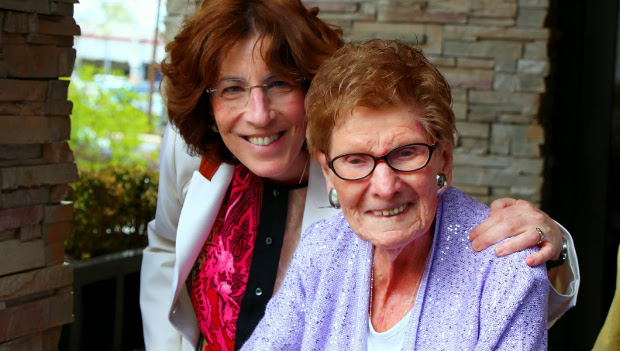The aging population: Are we ready for 2050?

Dr. Andrea LaCroix and her grandmother.
Dr. Andrea LaCroix writes that in 35 years, the American population aged 65+ will double. What can we do now for their health and independence?
by Andrea Z. LaCroix, PhD, professor and chief of Epidemiology, University California San Diego and a GHRI senior scientific investigator whose research focuses on older women’s health, especially prevention of heart disease, cancer, and disability.
In February, Time magazine’s cover featured a wide-eyed infant and the headline, “This baby could live to be 142 years old.” Yes, longevity is improving in the Western world. And the impact is not just on future generations but on people living now. My own grandmother recently celebrated her 101st birthday.
Joseph F. Coughlin, director of MIT AgeLab, notes these facts about our world today:
- Japan sells more adult diapers than baby diapers;
- Germany markets an “anti-aging” beer;
- In the U.S., 40 percent of women aged 65 and older live alone.
By 2050, the predicted number of people in the U.S who will be over age 65 is 88.5 million—more than double what it is today. This demographic change will have a major impact on health care, especially for women, who are more than half of the over-65 population. As Dorothy Rice, professor emerita at the University of California San Francisco School of Nursing, noted, in the future, America will be “a society dominated by older people, and many of them older women.”
Shifting the health paradigm toward maximizing function
So many of our health care studies, policies, and discussions are about avoiding chronic conditions such as heart disease, diabetes, and obesity. These are and should be high priorities for a maintaining a healthy population. However, as we prepare ourselves for a 2050 population with an estimated 19 million people older than age 85, we must accept that many people will develop chronic conditions despite our best prevention efforts.
To prepare for the coming expansion in the older segment of our population, we must learn to help the oldest people in our communities effectively manage multiple chronic conditions and maximize their function. Currently, nearly half of people who are older than 85 have problems walking. Many have difficulty with daily activities such as dressing, bathing, and eating.
Thankfully, we have an effective way to improve and preserve function for women and men of all ages: physical activity. The LIFE (Lifestyle Interventions and Independence for Elders) study reported in JAMA in 2014 showed that a physical activity program helped people in their 70s and 80s preserve the ability to walk. This is not the only trial to show the positive effects of exercise. I, and many of my colleagues who study aging, are convinced. We don’t need any more of our tax dollars paying for research on whether or not exercise has benefits.
Instead, it’s time to learn how to scale up physical activity programs so they work in big populations. I’m helping lead a new study—the Women’s Health Initiative Strong & Healthy (WHISH) trial—to look at the effects on the heart health of 50,000 women of the Go4Life program. Go4Life, which is available to anyone through the National Institute on Aging, has tips, videos, and workout plans to help people increase their aerobic activity, strength, balance, and flexibility.
I hope the National Institutes of Health and other U.S. funding agencies will continue to support WHISH and other studies that help us answer critical questions in preparation for 2050:
- How can we distinguish biological from chronological age to help people make health care decisions based on their abilities and needs?
- What are the best practices for managing multiple chronic conditions so older people keep their ability to walk and perform daily activities?
- How can we create environments for aging populations that encourage the social engagement and activity that slow physical and mental aging?
With the WHISH team and other researchers, I’m working to answer these questions to tackle the challenges of 2050. It’s only 35 years away, and we must be prepared.
Healthy Findings Blog
Living well, dying later in the US
14.8 years separates the life expectancies of the poorest one percent and the richest one percent.
Read about it in Healthy Findings.


